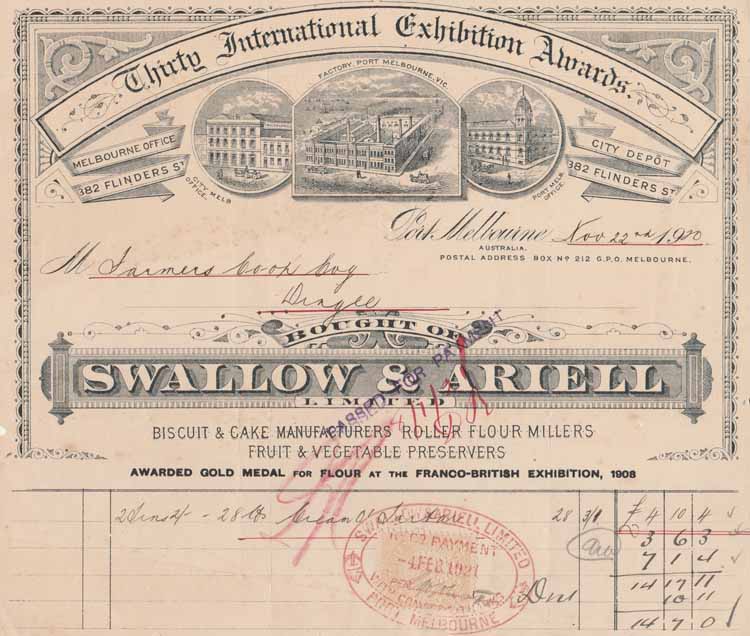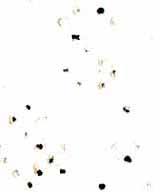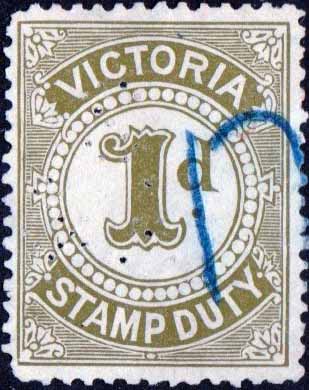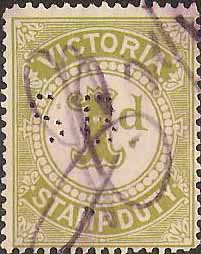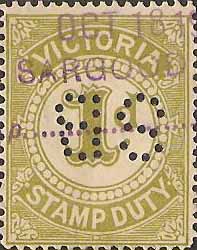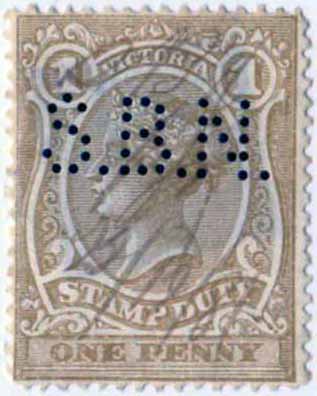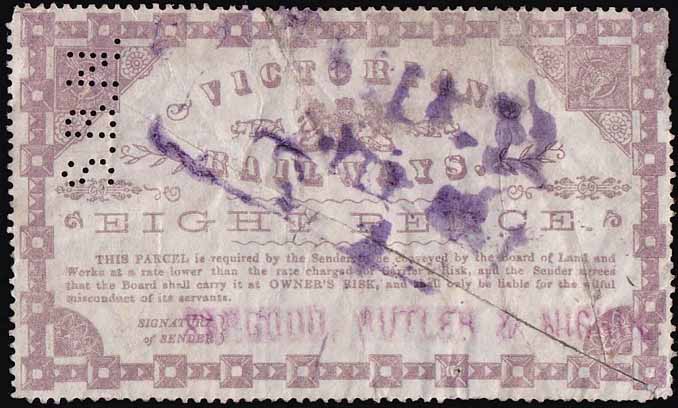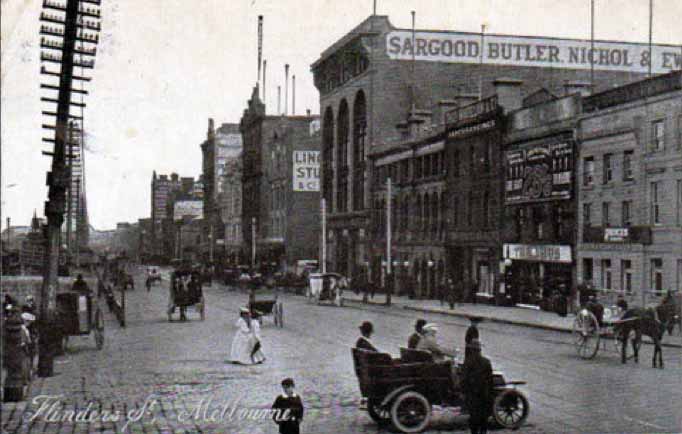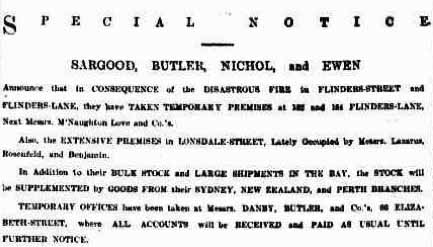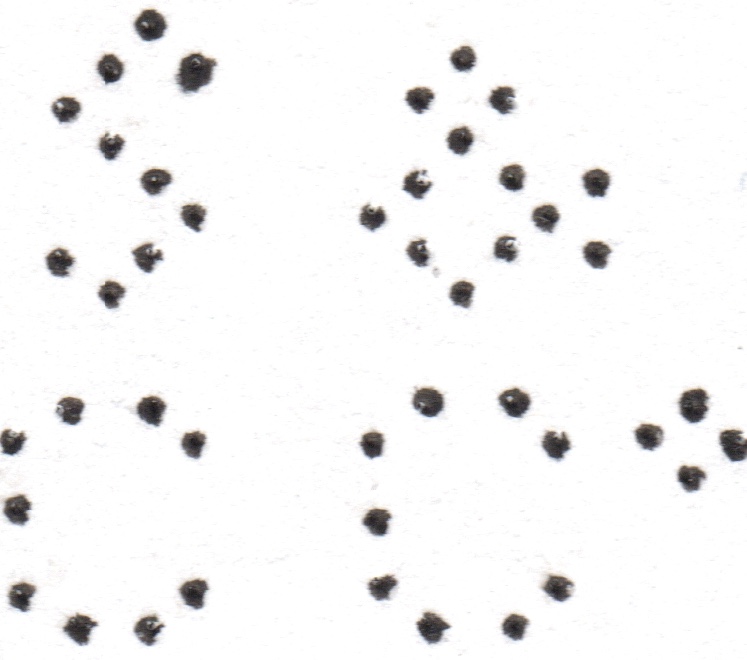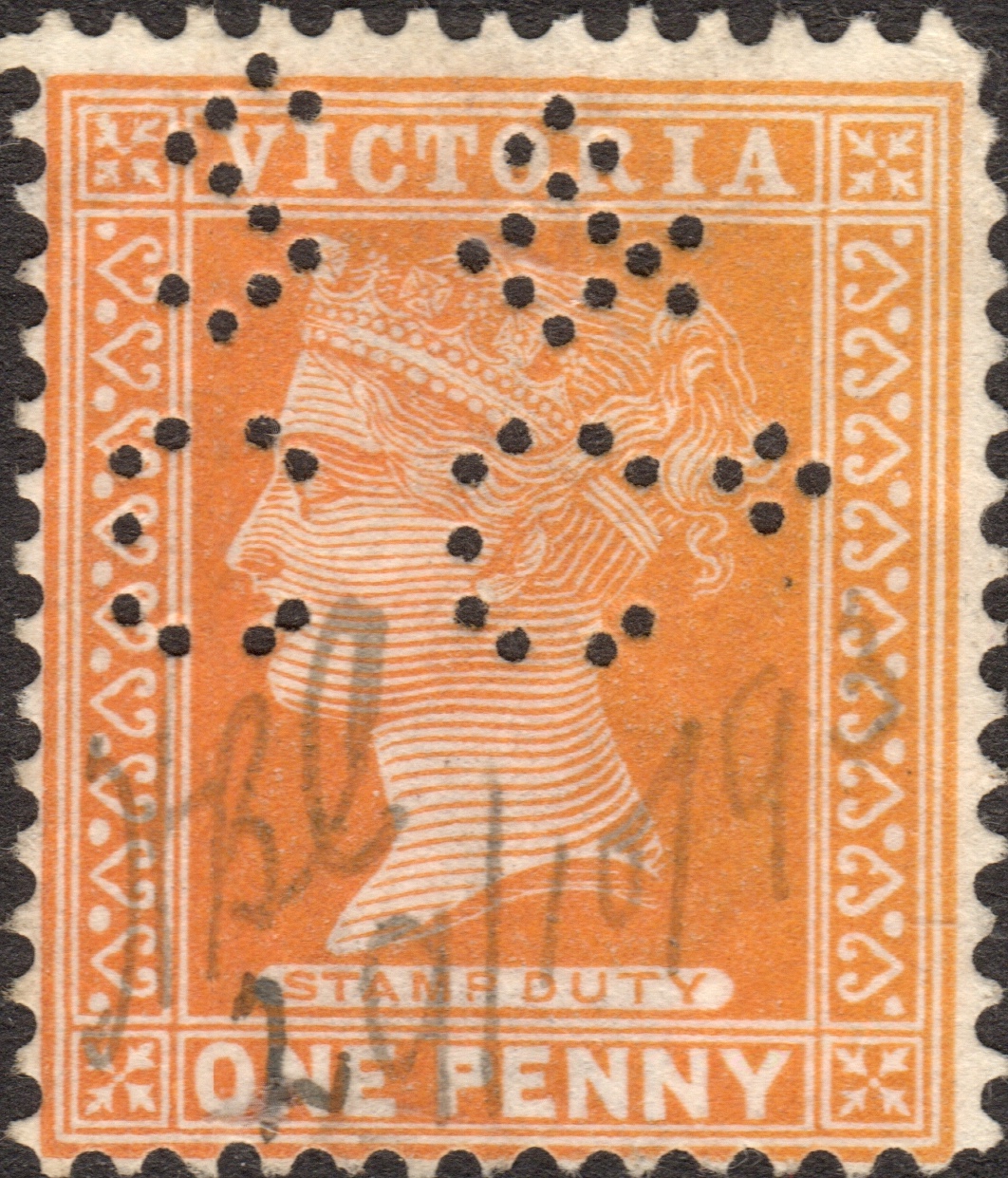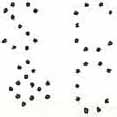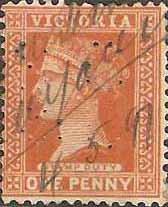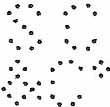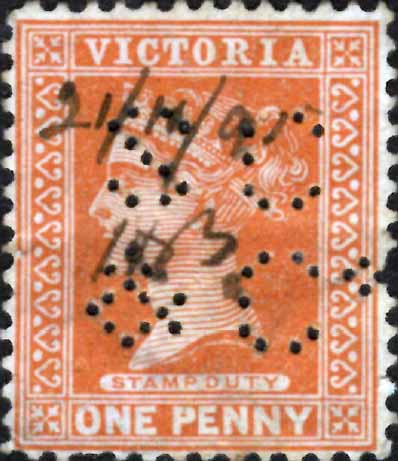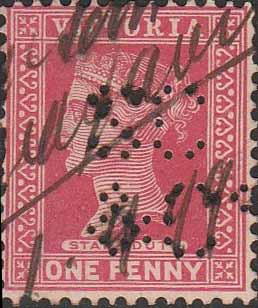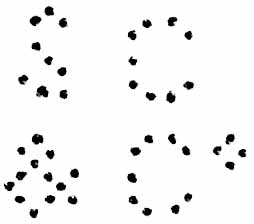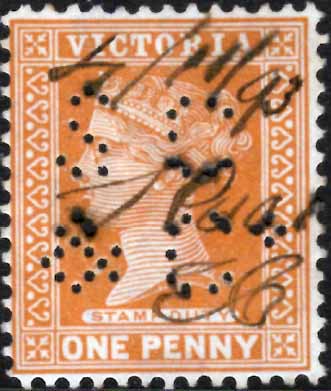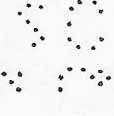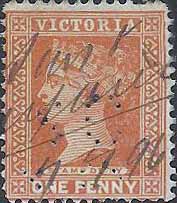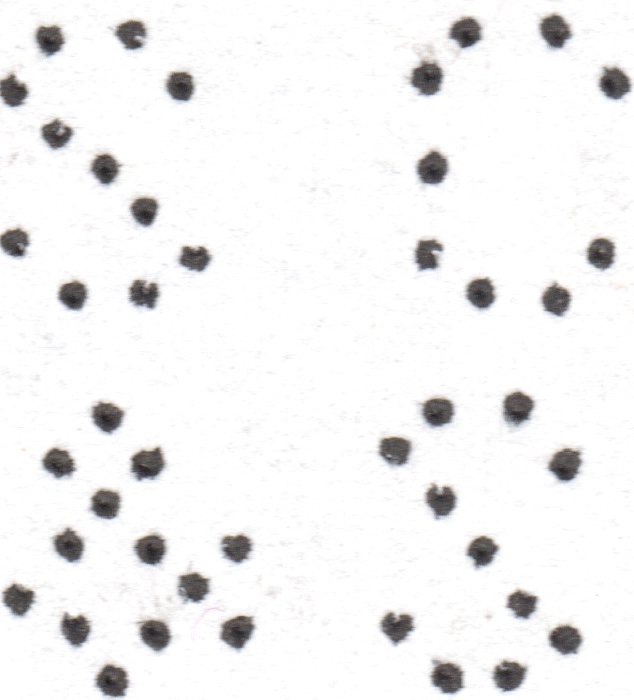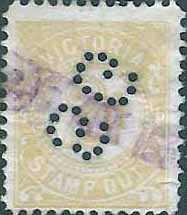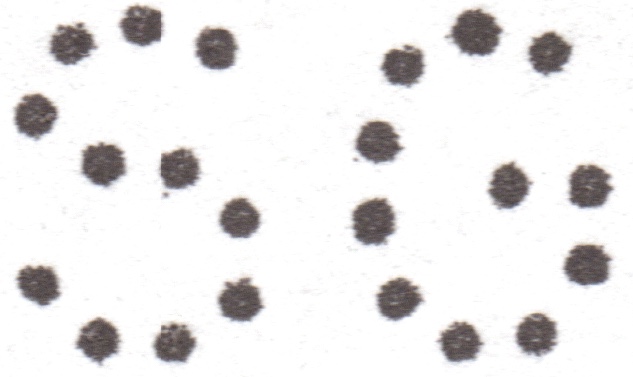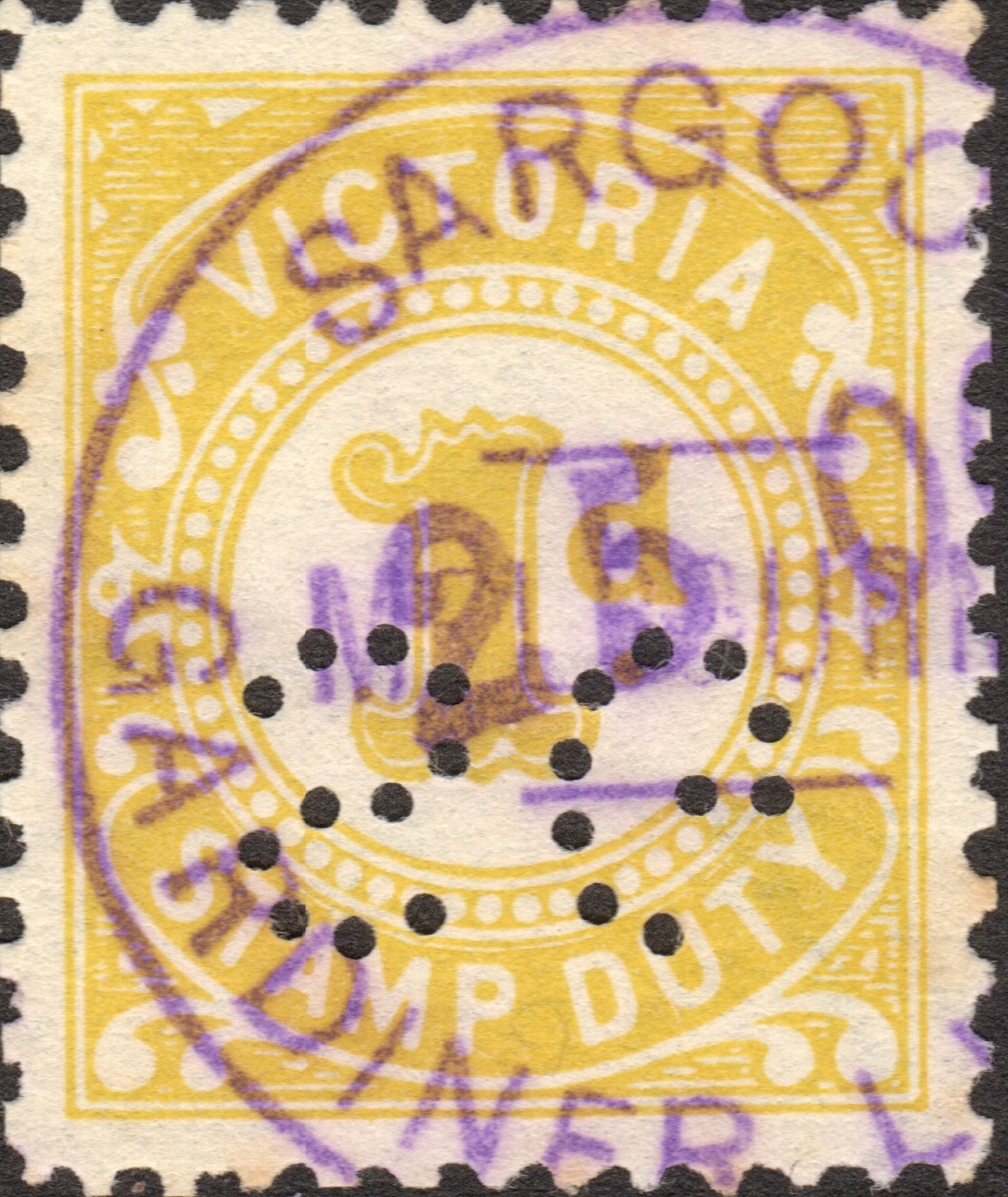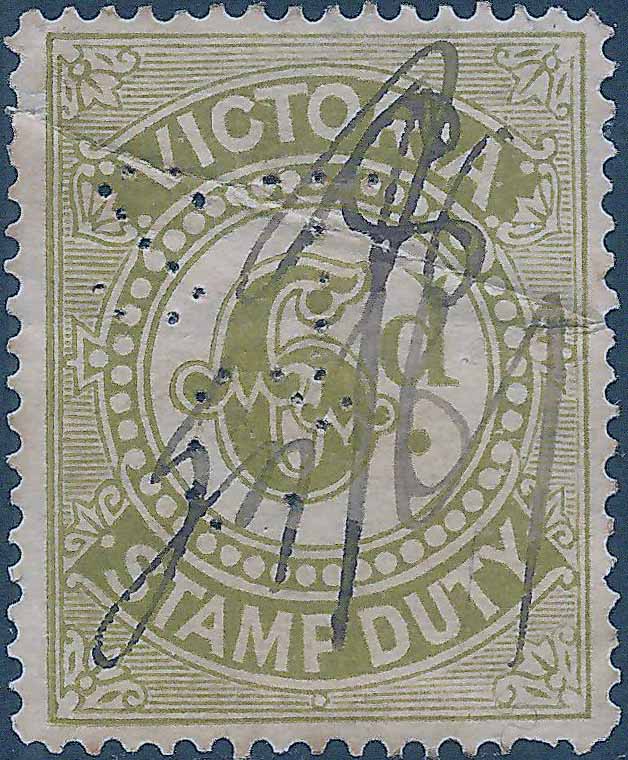|
Private Revenue Perfins of Victoria An Elsmore Coath production The authors would welcome your comments additions or input into this work A B C D E F G H I J K L M N O P Q R S T V W Y Other S -------------------------------------------------------- S&A.a
User: Swallow & Ariell Biscuit Makers Address: 60
Stokes St, Pt Melbourne, VIC
Revenue Use: 1911 Series 1d, 3d, 6d 1915 Series 2d Rarity Scale:
1911 Series 1d R4, 3d R4, 6d R4
1915 Series 2d R4
Background: *Thomas Harris Ariell
was born in 1832 in Middlesex, migrating to
Australia as a 20-year-old with his brother,
William Harris Ariell (b. 1830), in 1852. The pair
travelled aboard the “Hamlet” as cabin passengers,
arriving in Port Jackson in early January 1853. Thomas Swallow was
born in Berkshire in 1823; lured by the California
gold rush, he left England forever in 1843.
Swallow married Isabella Fulton of Vermont and in
April 1853, the siren calls of the Victorian gold
discoveries saw the couple boarding the “City
of Norfolk” bound for Australia. After an unsuccessful
year on the Ballarat gold fields, Thomas and
Isabella Swallow returned to Melbourne where, in
late 1854, he commenced making ships’ biscuits or
“Pilot and Navy bread” in rented premises at the
corner of Nott and Rouse Streets, Sandridge (Port
Melbourne). It is possible that Swallow had
earlier gained his biscuit making knowledge as an
apprenticed to Huntley & Palmer, biscuit
makers of Reading (England). In 1858, T. Swallow
& Co. moved to a three-storey building in
Rouse Street and by 1859 had become an “extensive
biscuit manufactory” supplying the entire
waterfront with ships’ biscuits. Swallow needed a
partner whom he found in Thomas Ariell, from
Geelong. The firm was now styled Swallow and
Ariell. By now, Swallow &
Ariell were making far more than ships’ biscuits.
The Burke & Wills Expedition took Swallow
& Ariell meat biscuits with them, and the
expedition’s fate might have been different if the
biscuits had been consumed. Business continued to
expand, servicing not only the ports of Sandridge
and Williamstown and the leading up-country towns,
but the whole of Victoria and parts of New South
Wales. Ariell was an able
partner, of “gentlemanly bearing and kindly
disposition” with a philanthropic bent. His death,
from an “internal abscess”, in July 1875, was a
considerable blow to Swallow. Earlier in the year,
in March, Thomas Ariell’s 8-year-old son had been
killed by a falling tree while on a visit to
Swallow’s Shepparton farm, which Swallow had
recently bought. In November 1877,
Frederick Thomas Derham, Swallow’s son-in-law
became a much-needed partner in Swallow &
Ariell. (Swallow’s three sons, enterprising but
extravagant agricultural pioneers, were unsuited
to the biscuit business.) Thomas Swallow’s
interests were not confined to the biscuit making
business. Convinced of the value of irrigation for
growing dried fruits (for biscuit and cake making)
he became a landowner in Shepparton in 1874. A
successful venture, fruit processing and canneries
were established in Mooroopna and Kyabram by 1900. A disastrous fire at
the Sandridge Sugar Works in 1875 encouraged
Swallow and Derham (in a company of that name) to
establish sugar cane plantations in Cairns in
1883. Crushing mills and treacle and golden syrup
refineries followed; the largest venture being the
Hambleton Mill later part of Colonial Sugar
Refinery, run by a son-in-law of Swallow’s, O.M.
Williams. Swallow’s son, William, had established
a large fruit farm near Cairns, extending and
perfecting cultivation which Thomas was never to
see when he died suddenly of pneumonia in Cairns
in July 1890. Thomas Swallow’s body
was escorted to St John’s Church, Cairns, by a
huge procession of mourners from every walk of
life. After the service, a procession headed by
the Masonic Order in full regalia escorted the
body to Cairns wharf where it was placed aboard
the steamer “Arawatta”. Swallow was
interred in Melbourne General Cemetery. Frederick Derham was
born in Bristol, in 1844, and arrived in Melbourne
as a 12-year-old in 1856. He gained experience
with Callender, Caldwell & Co. of King Street.
He then established his own business as a
mercantile broker and flour and grain agency,
developing a thriving export business which he
continued to operate when he joined Swallow &
Ariell. In 1883, Derham was
elected MLA for Sandridge (Port Melbourne)
retaining his seat until 1892. Between February
1886 and August 1890; he served as Postmaster
General in the Gillies-Deakin Government,
introducing the penny post to Victoria, parcel
post and country telephone services. When Swallow &
Ariell became a limited liability company in 1888,
Frederick Derham became joint managing director
with Thomas Swallow, and sole director in 1890
when Thomas Swallow died. In later years,
Derham was president of the Chamber of
Manufactures and of the Victorian Millowners’
Association. Frederick Thomas Derham died in March
1920 at Kew, and his eldest son, Frederick John
took his place as managing director of Swallow
& Ariell. On Frederick John
Derham’s death in 1932, management of the company
passed to his half-brother, Charles Alfred
Melbourne Derham who became managing director in
1947. On his death in 1959, a grandson of the
founder, another Frederick Thomas Derham, managed
Swallow & Ariell until it was taken over by
Australian Biscuit Co. in 1964. Swallow &
Ariell’s products ranged from the original ships’
biscuits (long unnecessary) to a huge assortment
of biscuits and cakes; wedding and birthday cakes,
plum puddings, dried fruits, treacle and golden
syrup, and perhaps their most recognised products
– Teddy Bear biscuits and Swallows ice cream. At
various times, other products included dog
biscuits, fruit mince, meringues, infant’s food
and aerated flour. Device: S&A.a is
a Single Die customised device that was used over
the period 1906 until at least 1942. Usage on
postage stamps is common but it is quite rare on
revenues and that usage seems to be limited to the
early usage period of the device. It is a large pattern
with quite thin pins but it seems to have been
well made and it produced clear strikes throughout
the life of the device. Related Patterns: VIC
S&A.b (unconfirmed) *Jenny O’Donnell
Research -------------------------------------------------------- S/&A.b
User: Swallow & Ariell Biscuit Makers Address: 60
Stokes St, Pt Melbourne, VIC Later 382 Flinders Street, Melbourne, VIC and other locations Revenue Use: 1911 Series 1d, Rarity Scale:
1911 Series 1d R4 Background: See
S&A.a Device: The S&A.b pattern
is made from a temporary die in a single die
format. Such devices, which could produce these
temporary patterns, were used by some Stamp
Vendors in Melbourne mainly from the late 1800’s
to the early part of the 20th Century. This particular
pattern is very rare on both revenues and postage
stamps and is only known around 1910. On postage
stamps Port Melbourne postmarks are most common so
this supports it being usage by Swallow and
Ariell. There are a small
number of these temporary patterns with similar
patterns around this time which is after the
company purchased and started using its customised
device S&A.a. This seems odd but could be
explained by a short period of outage for the main
machine or a peak period of demand for stamps by
the company. Related Patterns: VIC
S&A.a -------------------------------------------------------- SB.a
User: Sargood Brothers Warehousemen
Address: 240-248
Flinders St, Melbourne, VIC Revenue Use: 1902 Series 1d 1915 Series 2d Rarity Scale:
1911 Series 1d R4
1915 Series 2d R4 Background:
*Frederick Thomas Sargood (later Sir) was born on
30 May 1834 at Walworth, London, son of Frederick
James Sargood (d.1873), a merchant, and his wife
Emma, (nee Rippon). Frederick (junior)
arrived in Melbourne with his parents and five
sisters in February 1850. After a short period as
a clerk Frederick joined his father’s wholesale
soft goods business named Sargood, King & Co.
Between 1852-54 he spent time on the Mount
Alexander goldfields as well as managing the
companies interests in the Bendigo-Castlemaine
area. In 1858 he married
Marian Rolfe and in 1859 became a junior partner
in Sargood, King & Co. His father had entered
politics but by 1860 he had returned to England.
Frederick (senior) died in 1873. The company prospered
and in 1863 they extended their interests
interstate, including Sydney and into New Zealand,
where the Company was known as Sargood and Sons
and Ewen. On his father’s death Frederick enacted
an option in the will to purchase both the
Australian and New Zealand business. In 1874 Frederick
entered the Victorian parliament in the
Legislative Council and in 1879 he oversaw the
merger of the family business with the firm of
Martin, Butler and Nichol, and by the late 1880’s
the company was known as Sargood, Butler, Nichol
and Ewen. In 1880 after the
death of his wife Marion he retired from politics
and took his 9 children to England. Whilst there
Frederick remarried (to Julia Tomlin) and 1882 the
family returned to Melbourne. Frederick and his
sons returned to the family business and by 1897
the company had 14 branches around Australia and
New Zealand and employed over 5000 people. They
had an office in London, managed by Nichol and
Ewing and agencies in New York, Yokohama (Japan)
and Hong Kong. Frederick died in
January 1903 and was survived by his wife and the
5 sons and 4 daughters of his first marriage. The company was
reformed as Sargood Brothers in 1906 following the
retirement of Henry Butler and Robert Nichol and
continued to trade successfully until it was
merged with William Gardiner and Co (Sydney) in
1926 to become Sargood Gardiner. See also Background
for Sargood Gardiner under SG.a Device: The SB.a
device was a single die customised device and it
was in service for the period 1906–1926 although
usage after about 1910 is rather rare. The strikes
after C1910 are rather poor and indistinct and it
would seem that the Company only chose to use the
device on odd occasions, perhaps in response to a
period of large mail volumes or when one of their
other devices was inoperable. The company had at
least three devices operating at the same time as
follows: SB.a 1906 – 1926 SB.# 1907 – 1916 SB.b 1907 – 1927 These are all
reported used on postage stamps but SB.# has not
been seen on revenues as yet. However, it is
logical that it would exist but revenue use of
these patterns is very rare so it is possible that
no example will surface. Related Patterns:
Refer to other William Gardiner and Co and
Sargoods patterns in: VIC: SB.b, SBN.a,
SG.a, SG.b NSW: SB/NE.a, WG/CO.a
WG&CO.a WG/&/COLD.a
WG/&/COLD.b QLD: W.G&Co.a See also S section 2
Security Commercial Overprints of Victoria *Trove and Australian
Dictionary of Biography -------------------------------------------------------- SB.b
User: Sargood Brothers Warehousemen
Address: 240-248
Flinders St, Melbourne, VIC Revenue Use: 1902 Series 1d 1915 Series 2d Rarity Scale:
1902 Series 1d R4
1915 Series 2d R4 Background: See SB.a Device: This is a
Single Die customised device, See SB.a. Related Patterns:
Refer to other William Gardiner and Co and
Sargoods patterns in: VIC: SB.a, SBN.a,
SG.a, SG.b NSW: SB/NE.a, WG/CO.a
WG&CO.a WG/&/COLD.a
WG/&/COLD.b QLD: W.G&Co.a See also S section 2
Security Commercial Overprints of Victoria
S.B.N..a -------------------------------------------------------- S.B.N..a
User: Sargood, Butler & Nichol Warehousemen Address: 240-248 Flinders St, Melbourne, VIC Revenue Use: 1884 Duty Stamp Series 1d (brown), 1/-, 2/- 1886-1899 Series, inscribed 'STAMP DUTY' 1d (green) Rarity Scale:
1884 Duty Stamp Series 1d R4, 1/- R4, 2/- R4
1886-1899 Series 1d R4 Railway Use: 1882 issue 8d Railway Scale:
1882 issue 8d R4 Background: See SB.a Device: SBN.a is a
Single Die customised device that was used between
1883 and 1897. This was one of the first
perforating machines used in Victoria and it
generally produced clear strikes over its life. The device was
replaced in C1897 by a similar device SBN/&E
which reflected the changes in ownership, and this
happened again in about 1906/7 when the company
became Sargood Brothers, see SB.a Background and
SB.a Device. Related Patterns:
Refer to other William Gardiner and Co and
Sargoods patterns in: VIC: SB.a, SB.b,
SG.a, SG.b NSW: SB/NE.a, WG/CO.a
WG&CO.a WG/&/COLD.a
WG/&/COLD.b QLD: W.G&Co.a See also S section 2
Security Commercial Overprints of Victoria
-------------------------------------------------------- S&/CCo.a
User: Unknown Unknown Address: Melbourne, VIC Revenue Use: 1886-1899 Series, inscribed 'STAMP DUTY' 1d (shades) Rarity Scale:
1886-1899 Series 1d R4 Background: Unknown Device: The S&/CCO.a
pattern is made from a temporary die in a single
die format. Such devices, which could produce
these temporary patterns, were used by some Stamp
Vendors in Melbourne mainly from the late 1800’s
to the early part of the 20th Century. This particular
pattern is very rare and to date it has only been
seen used on revenue stamps and then only with
usage in October of 1893. The user is unknown,
and it is possible that it was intended to be
SC/&C or SC/&CO or similar, but it was set
up in the punch head incorrectly. Given the rarity of
the pattern and the variation that is found in
these Temporary patterns it is very likely that we
will never know. Related Patterns: Nil -------------------------------------------------------- SC/&C.a
User: Sidney Cooke & Co(unconfirmed) Printers Supplies Address: 330-332 Flinders Lane, Melbourne, VIC Revenue Use: 1886-1899 Series, inscribed 'STAMP DUTY' 1d (shades) Rarity Scale:
1886-1899 Series 1d R4 Background: * Sidney
Cooke was born in 1846 in Manchester and was a
lithographer by trade (having done his
apprenticeship with his father) and he arrived in
Victoria aboard the “Hydaspes” in September 1871,
aged 25. After a short period with the renowned
Charles Troedel, Cooke was joined in Melbourne by
his brother John George Cooke. The pair commenced
trading as Cooke Bros in Argus Passage, off 78
Collins St East (next to The
Argus newspaper
office) before moving in late July 1877, to a tiny
factory at 1 Little Lonsdale St East. The business
advertised as printers’ brokers, importers and
manufacturers of printing ink and importers of
“the best colours”. The partnership was
terminated shortly after, in September 1877, when
Sidney Cooke bought out his brother. (George Cooke
became a house and land agent at 18 Collins St E.
selling villa residences and business sites in
Surrey Hills (1885) and later Hastings (1888) when
he was at Victoria Buildings in Swanston Street.) Shortly after George
Cooke’s departure Sidney Cooke purchased the
business of Freemantle & Co. (established
1853), suppliers of printing machinery, and moved
his office and warehouse to larger premises at 42
Little Flinders Street West, retaining the Little
Lonsdale Street premises for the manufacture of
ink. A small varnish works was established in
1877, also. In 1881, the firm
became S. Cooke & Co., “Printers’ brokers and
printers’ ink manufacturers” at 42 Lt Flinders St
W., Lt Lonsdale St E. and Long St, Footscray, when
Sidney Cooke entered into partnership with John
Atherton Horsfall. In February 1887, the
partnership with Horsfall was dissolved. The business
continued to prosper as agencies for English,
German and American equipment were obtained and in
1890, two cottages in Kavanagh Street, South
Melbourne were purchased to establish an
engineering department to service and repair
printing machines. Thus, began the company’s
diversification. Also, in 1890, S. Cooke &
Co., now “printers’ furnishers, printing ink
manufacturers and printers’ engineers”, moved its
main warehouse and offices to more substantial
premises at 330 -332 Flinders Lane. The origins of the
Fasteners Division of Sidney Cooke Ltd are traced
to 1891 when S. Cooke & Co. commenced
manufacture, at its depot in South Melbourne, of
the Evenden Springhead Roofing Nail (under licence
from its inventor), purchasing the patent in 1895.
The operations of
Head Office, showrooms, the Ink Department and
machinery sales were moved to a five-storey
freehold warehouse at 225 Queen Street, in 1911.
The South Melbourne factory was completely rebuilt
in 1920 and an extensive new product range added.
Rival company F. Golds Nails Pty Ltd in Richmond
was acquired in January 1926; while S. Cooke
(Sydney) Pty Ltd was formed in January 1929 and S.
Cooke (Adelaide) Pty Ltd in July 1930. A disastrous fire at
the South Melbourne plant in 1933 resulted in the
company moving to a 5-acre site in Gamble St,
Brunswick. In 1938, over-crowding at the Queen
Street building saw a brand-new ink factory opened
at 469 Lt Bourke St. In 1945, Sidney Cooke
Pty Ltd, “importers of printers’ machinery and
supplies, and manufacturers of printers’ inks,
screws, nails, etc.” was converted into a public
company and entered a period of rapid expansion. A subsidiary
business, Australian Wire Mills Ltd, (Adelaide) an
engineering and nail-manufacturing concern, was
acquired in 1947, Wire Products Pty Ltd, (Sydney)
was acquired in 1948 and United Nails Pty Ltd
(Sydney) in 1949. A Brisbane factory was opened in
1958. In November 1948, seven acres of land in
Brooklyn (Melbourne) were acquired, for a factory,
bulk store and laboratory. In July 1949, Sidney
Cooke Ltd, printers’ furnishers, entered into an
agreement with Interchemical Corporation of New
York, under which a new subsidiary, Sidney Cooke
(Printing Inks) Pty Ltd was created to manufacture
specialty printing inks. A New Zealand company
CMI Screws and Fasteners Ltd tells the story
(2017) that Sidney Cooke stepped out for lunch one
day, saw a ‘For Sale’ sign outside a company who
were wire nail manufacturers, stepped inside and
emerged later as the owner of what became Sidney
Cooke Fasteners Pty Ltd. In the mid-1960s
Sidney Cooke Fasteners (NZ) became an associate
company of CMI who purchased the holdings of
Sidney Cooke Fasteners (NZ). Sidney Cooke
Fasteners Pty Ltd of Collins St, Melbourne, was
deregistered as a company in 2007. Sidney Cooke managed
the company from 1872 until his death at his home,
“Chromhurst” in Surrey Hills (Melbourne), in June
1903. In 1965, a grandson, Lawton Cooke, became
managing director. Device: The SC/&C.a pattern is made from
a temporary die in a single die format. Such
devices, which could produce these temporary
patterns, were used by some Stamp Vendors in
Melbourne mainly from the late 1800’s to the early
part of the 20th Century. This particular
pattern is very rare and to date it has only been
seen used on revenue stamps and then only with
usage in 1897. The user is suspected
to be Sidney Cooke &
Co, but this is
unconfirmed. It is possible that it was intended
to be SC/&Co, but it was set up in the punch
head incorrectly. Given the rarity of
the pattern and the variation that is found in
these Temporary patterns we may never know. Related Patterns:
SC/&Co.a, SC/&Co.b, SC/&Co.c *Jenny O’Donnell
Research -------------------------------------------------------- SC/&Co.a
User: Sidney Cooke & Co(unconfirmed) Printers Supplies Address: 330-332 Flinders Lane, Melbourne, VIC Revenue Use: 1886-1899 Series, inscribed 'STAMP DUTY' 1d (shades) Rarity Scale:
1886-1899 Series 1d R4 Background: See
SC/&C.a Device: The SC/&Co.a pattern is made from
a temporary die in a single die format. Such
devices, which could produce these temporary
patterns, were used by some Stamp Vendors in
Melbourne mainly from the late 1800’s to the early
part of the 20th Century. This particular
pattern is scarce on postage stamps but rare on
revenues. The pattern is reported over the period
1896 – 1901 and because of this extended period of
use there are variations in the settings that are
used on the temporary die. There are about 20
varieties of the pattern known on postage stamps
but only 2 on revenues due to the rarity. Related Patterns:
SC/&C.a, SC/&Co.b, SC/&Co.c -------------------------------------------------------- SC/&Co.b
User: Sidney Cooke & Co(unconfirmed) Printers Supplies Address: 330-332 Flinders Lane, Melbourne, VIC Revenue Use: 1886-1899 Series, inscribed 'STAMP DUTY' 1d (shades) Rarity Scale:
1886-1899 Series 1d R4 Background: See
SC/&C.a Device: The SC/&Co.b pattern is made from
a temporary die in a single die format. Such
devices, which could produce these temporary
patterns, were used by some Stamp Vendors in
Melbourne mainly from the late 1800’s to the early
part of the 20th Century. This particular
pattern is rare on both postage and revenue
stamps. The pattern is only reported over the
period 1893 – 94 and because of this relatively
short period of use and the general rarity of
revenue use there is only a single type of the
settings that are used on this temporary die found
on revenues to date. There are about 4 varieties
of the pattern known on postage stamps. Related Patterns:
SC/&c.a, SC/&Co.a, SC/&Co.c -------------------------------------------------------- SC/&Co.c
User: Sidney Cooke & Co(unconfirmed) Printers Supplies Address: 330-332 Flinders Lane, Melbourne, VIC Revenue Use: 1886-1899 Series, inscribed 'STAMP DUTY' 1d (shades) Rarity Scale:
1886-1899 Series 1d R4 Background: See
SC/&C.a Device: The SC/&Co.c pattern is made from
a temporary die in a single die format. Such
devices, which could produce these temporary
patterns, were used by some Stamp Vendors in
Melbourne mainly from the late 1800’s to the early
part of the 20th Century. This particular
pattern is rare on both postage and revenue
stamps. The pattern is only reported over the
period 1896 – 99 but despite this relatively broad
usage period the setting is very rare. Revenue
usage is only known in 1896. Related Patterns:
SC/&c.a, SC/&Co.a, SC/&Co.b -------------------------------------------------------- SC/&S.a
User: S Cohen & Sons Hardware Merchants
Address: 380 Lonsdale
Street, Melbourne, VIC Revenue Use: 1886-1899 Series, inscribed 'STAMP DUTY' 1d Rarity Scale:
1886-1899 Series 1d R4 Background: *Simon (Simeon) Cohen
was born in 1825 in Bomst, in Posen, Prussia
(modern day Poznan, Poland). A jeweller by trade,
he emigrated with his wife on “Champion of the
Seas” arriving in Melbourne in December 1854. In
1857, he obtained his Naturalization Certificate;
at the time he was living in Ballarat East,
Victoria, where his seven children were born
between 1857 and 1873. In 1865, Simon Cohen
had an ironmongery on Main Road, Ballarat East.
Early in the same year, he moved to new “centrally
situated” premises opposite the Chamber of
Commerce in Sturt Street, Ballarat, selling
“furnishings and general ironmongery”. Described in 1878 as
next to the Theatre Royal in Sturt Street, S.
Cohen, ironmonger, was an agent for Wertheim
sewing machines which he promoted
enthusiastically. The business became S. Cohen and
Sons late in 1884. A new branch was
established in 1885 opposite the Ballarat
Haymarket on the corner of Mair and Armstrong
Streets. Ideally located to service agricultural
needs, it sold chaffcutters, corn crushers,
kibblers, fencing wire, ropes and twine. The
business, now “wholesale and retail ironmongers”,
was promoted as being direct importers of goods. Business expanded
rapidly and S. Cohen and Sons opened Melbourne
premises at 41 Post Office Place in 1886. At the
same time, Simon Cohen toured America and the
Continent “seeking new novelty” products to sell
among them “French Art electroplated ware”. The
firm moved to 380 Lonsdale Street in 1888. Simon Cohen (late of
Ballarat) died at his Alma Road, St Kilda, (cnr
Westbury Street) residence on 21 February 1890.
Simon’s death resulted in a partnership being
formed between Joseph Alfred Cohen (b. 1857,
Ballarat E.) and L. Buchholz (or Buckholts), the
business being styled S. Cohen, Sons & Co. Joseph Albert Cohen
retired in 1897, the company was carried on by the
remaining partner. (The business at 105 Sturt
Street, Ballarat was retained.) In early 1898, the
wholesale warehouse was relocated to new premises
at 380 Lonsdale Street, Melbourne, where it
continued before relocating in 1910 to 310 King
Street. In 1914, the company
was described as iron merchants, under which
designation it continued when relocating, yet
again in 1916, to 260 Queen Street; the branch at
315 Sturt Street, Ballarat, continued to be
described as ironmonger. By this time S. Cohen
Sons & Co. was a listed company now adding
‘Propriety Limited’ after its name. S. Cohen Sons &
Co. continued to trade from its Melbourne premises
until 1928 and from 315 Sturt Street, Ballarat,
until 1931. Device: The SC/&S.a pattern is made from
a temporary die in a single die format. Such
devices, which could produce these temporary
patterns, were used by some Stamp Vendors in
Melbourne mainly from the late 1800’s to the early
part of the 20th Century. This particular
pattern is fairly common on postage stamps but
rare on revenues. The pattern is reported over the
period 1899 – 1905 and because of this extended
period of use there are variations in the settings
that are used on the temporary die. There are
about 25+ varieties of the pattern known on
postage stamps but only 2 on revenues due to the
rarity. Revenue use is reported C1900. Related Patterns: Nil *Jenny O’Donnell
Research -------------------------------------------------------- SG.a
User: Sargood, Gardiner Pty Ltd Warehousemen Address: 61-73 Flinders Lane, Melbourne, VIC Revenue Use: 1915
Series: 2d, 3d on 2d. Rarity Scale:
1915
Series 2d R4, 3d on 2d R4. Background: *William
Gardiner and Co were warehousemen, and they were
headquartered in a substantial building in York
Street, (Sydney). The building had 8 floors with
large internal lifts and two street frontages, and
the company also held an adjoining property in
Clarence Street. In addition, they had a buying
office in London and offices and representatives
in Brisbane, Newcastle, West Maitland and the
Pacific Islands. In December 1926 they
amalgamated with fellow soft goods company, and
perfin user, Sargood Brothers (Melbourne and
Sydney) to form Sargoods Gardiner Pty. Ltd. The 71
York Street property was sold, and the new company
moved into a building that Sargoods had in
construction at 24–26 York Street which was later
named “Gardiner House”. See also Background
for Sargood Brothers under SB.a Device: SG.a is a
Single Die customised device that was used over
the period 1927 until at least 1940. Usage on
postage stamps is common but it is quite rare on
revenues. When the device was
introduced in 1927 it was fitted with relatedly
thin pins, but these seem to have been changed as
early as 1928 as all usage from that time is with
slightly thicker pins. All revenue use reported to
date is with the thicker pins. The device was
retired in 1940 which seems odd as it was still
producing readable strikes, and it was replaced by
the SG.b device. Related Patterns:
Refer to other William Gardiner and Co and
Sargoods patterns in: VIC: SB.a, SB.b,
SBN.a, SG.b NSW: SB/NE.a WG/CO.a
WG&CO.a WG/&/COLD.a
WG/&/COLD.b QLD: W.G&Co.a See also S section 2
Security Commercial Overprints of Victoria *Jenny O’Donnell
Research
-------------------------------------------------------- SG.b
User: Sargood, Gardiner Pty Ltd Warehousemen Address: 61-73 Flinders Lane, Melbourne, VIC Revenue Use: 1915
Series: 2d, 3d on 2d. Rarity Scale:
1915
Series 2d R4, 3d on 2d R4. Background: * See
SG.a Device: SG.b is a
Single Die (see below) customised device that was
used over the period 1941 until at least 1955.
Usage on postage stamps is common but it is quite
rare on revenues. Now some strikes of
this pattern on multiples show consistent
separation between dies and this is a
characteristic of a multiple die device. There are
also multiples that do not show this consistent
separation and further they show consistent
missing pins, which is a characteristic of a
single die device. It is conceivable,
although unlikely, that there were 2 devices that
produced an identical pattern, one a multi die
device and the other a single die device. More
research is needed. The device was
retired in 1955 and like the earlier SB.a device
it still seemed sound and was making readable
strikes. Related Patterns:
Refer to other William Gardiner and Co and
Sargoods patterns in: VIC: SB.a, SB.b,
SBN.a, SG.b NSW: SB/NE.a WG/CO.a
WG&CO.a WG/&/COLD.a
WG/&/COLD.b QLD: W.G&Co.a See also S section 2
Security Commercial Overprints of Victoria -------------------------------------------------------- ST/Co.a
User: The States Tobacco Co
Pty Ltd
Address: 226 Queens
St, Melbourne, VIC Later from 1907 A’Beckett St, Melbourne, VIC Revenue Use: 1911 Series 6d Rarity Scale:
1911 Series 6d R4 Background: *The States Tobacco Co
Pty Ltd of Melbourne, Sydney, Adelaide, Brisbane
and Fremantle came into existence as a joint stock
company on 25 March 1902. The company took over
the following businesses: . Jacob, Hart &
Co., Melbourne, tobacco and cigar merchants, and
cigar manufacturers . Sutton & Co.,
Sydney, tobacco and cigar merchants; NSW agents
for T.C. Williams Co.’s “Victory” and “Diadem” and
Dunlop’s “Derby” tobacco and for “Hanas” cigar. The cigar and tobacco
ware branch only of the businesses of: . Dixon & Sons Ltd,
Sydney and Brisbane . Robert Dixon &
Co., Adelaide and Fremantle The board of
directors comprised: L.P. Jacobs and E.H. Jacobs
representing Jacob, Hart & Co.; E.L. Sutton
and C.H. Reading, representing Sutton & Co;
W.E. Shaw of Dixon & Sons and H.H. Dixon of
Robert Dixon & Co. The company carried
on business from the cities in which its parent
companies operated, Tasmanian business being cared
for from the Melbourne offices located at 226
Queen Street. The purpose of the
company was to carry on the business of
manufacture, import and export of and as dealers
in cigars, cigarettes, snuffs, match lights, pipes
and other items for tobacco users. In effect, the
company’s purpose was to compete more effectively
with its rivals Australasian Tobacco and W.D. and
H.O. Wills. In Melbourne, the
company was first located in Queen Street but
moved to 46 A’Beckett Street in late 1907 where it
was still located in 1955. Device: The ST/Co.a pattern is made from
a temporary die in a single die format. Such
devices, which could produce these temporary
patterns, were used by some Stamp Vendors in
Melbourne mainly from the late 1800’s to the early
part of the 20th Century. This particular
pattern is rare on postage stamps but even harder
to find on revenues. The pattern is reported only
in 1903 and because of this short period of use
there are only about 4 variations in the settings
that are used on this temporary die, and these are
all found on a postage stamps. Only a single
setting is found on revenue stamps. Related Patterns: Nil *Jenny O’Donnell
Research -------------------------------------------------------- A B C D E F G H I J K L M N O P Q R S T V W Y Other © copyright 2011 |


